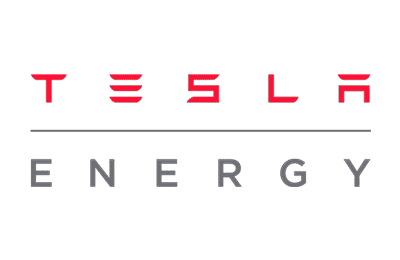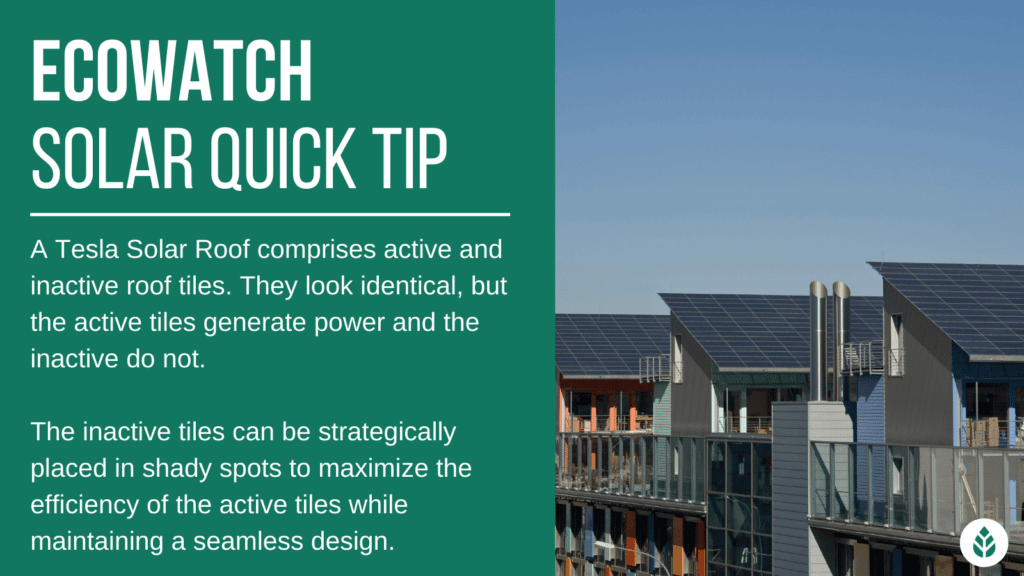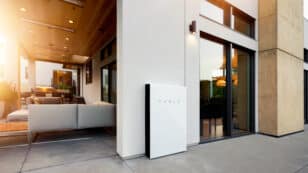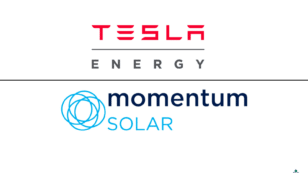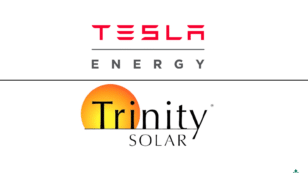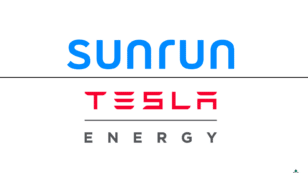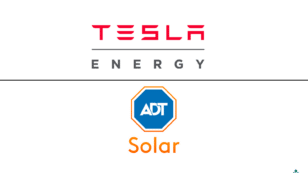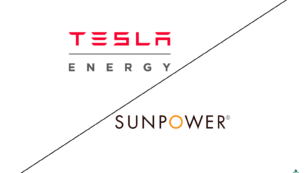
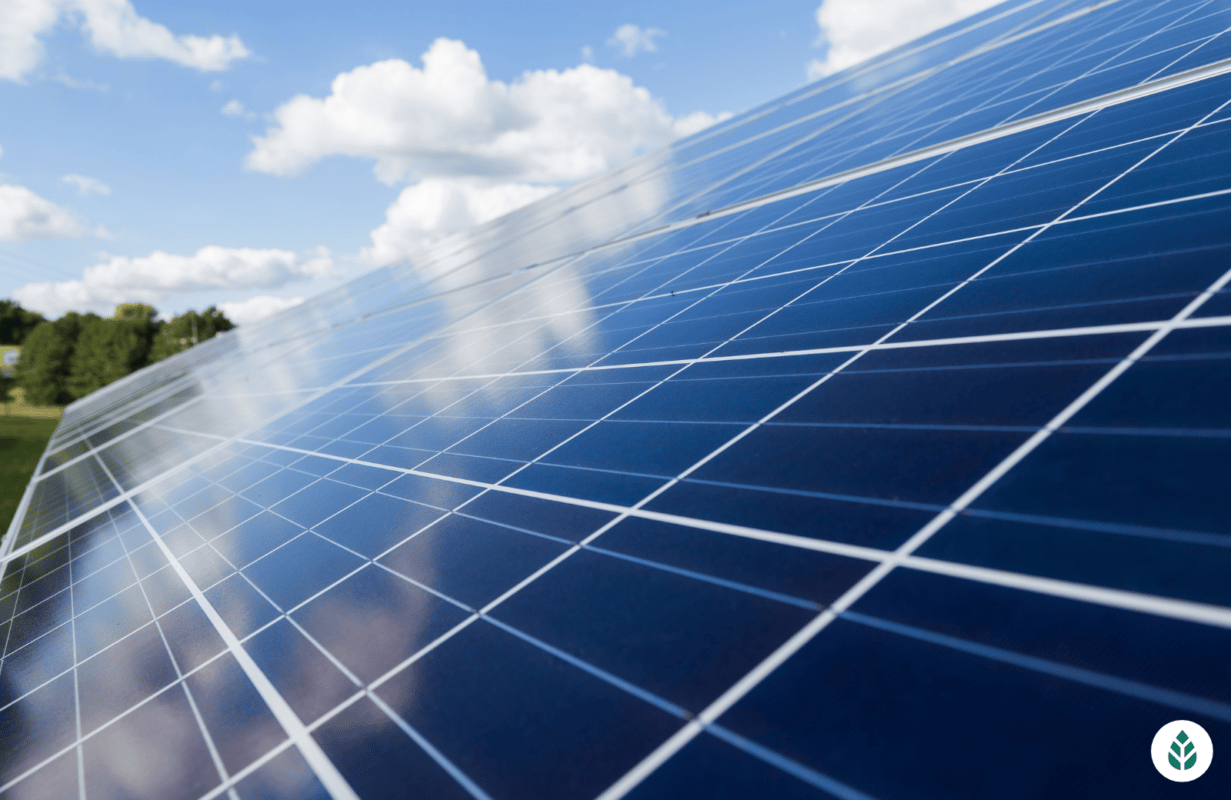
Tesla Solar Roof Cost & Review (Is It Worth It In 2024?)
In this guide, you’ll learn:
- How does Tesla Solar Roof work?
- How much does the Tesla Solar Roof cost?
- Is the Tesla Solar Roof worth it?
Join thousands of other homeowners in determining whether its right for you!
Each product and or company featured here has been independently selected by the writer. You can learn more about our review methodology here. If you make a purchase using the links included, we may earn commission.
What Is the Tesla Solar Roof?
In 2016, CEO Elon Musk unveiled the Tesla Solar Roof, a futuristic product consisting of photovoltaic (PV) roof tiles capable of generating clean energy. The roof is designed to maximize your energy production without sacrificing the aesthetics of your home. This addresses one of the most common complaints surrounding solar panels: the way the panels look.
Although the idea started trending quickly, it took almost two years for Tesla’s solar shingles to make their way onto the roofs of real homeowners. After a few more years of improvements, we’re finally seeing Tesla Solar Roof installations become more common.
Tesla’s Solar Roof tiles integrate the functionality of solar cells into roof tiles, making it possible for one product to offer two different uses. Categorized under Building Integrated Photovoltaics (BIPV), solar roof shingles look much sleeker than traditional residential solar panels, transforming the aesthetics of a roof equipped with solar.
While there have been other solar shingle products on the market, Tesla’s textured glass tile shingles offer some remarkable advantages. These include a 25-year warranty and impressive hail, fire and wind ratings. Tesla claims its shingles offer more durability and weather protection compared to traditional roof shingles.

Tesla Energy
Pros
- Price-match guarantee
- Sleek, efficient and durable solar panels
- Best solar battery on the market
Cons
- Some reported issues with customer service
- Customer service varies by local dealer
How Does the Tesla Solar Roof Work?
The first few attempts at BIPV solar roofs were made by pasting flexible solar panels over regular shingles. However, it was an inefficient method with questionable durability.
When Tesla got into the solar game and designed its solar roof tiles with subsidiary SolarCity, it integrated solar cells directly into the shingles (initially using a Panasonic cell before parting ways with the company).1 This makes the solar cells almost impossible to spot.
A Tesla Solar Roof comprises two types of roof tiles — active and inactive. They look identical, but the active tiles generate power and the inactive do not. Most homes only need part of their roof to be covered in active tiles to offset their energy bills. The inactive tiles can be strategically placed in shady spots to maximize the efficiency of the active tiles while maintaining a seamless design.
Solar shingles generate direct current (DC) power, so a Tesla roof also needs an inverter to turn it into usable alternating current (AC) power for your home. Tesla recommends adding a Powerwall battery to the system as well. This lets homeowners store solar energy for use at night or as backup power during a grid outage.
Watch Below: Check out this video from a real Tesla Solar Roof owner to learn more about whether the roof is a good option for you:
How Much Does the Tesla Solar Roof Cost?
We evaluated a typical house in California with a 2,000-sqare-foot roof and an average electric bill of $169.20 per month. According to Tesla, such a home would require a 8.1 kilowatt (kW) Solar Roof to meet current and future needs. Along with the recommended Powerwall, this would cost $57,351 after factoring in incentives like the federal tax credit (the system would cost $81,930 without the tax credit).
Without an energy storage system, the roof would cost about $45,851. Tesla also charges for tearing off an existing roof. In this example, roof removal costs $7,700.
Here’s a breakdown of Tesla roof pricing for the home we analyzed:
| Tesla Roof Installation Components | Cost |
| 8.1 kW Solar Roof | $62,730 |
| Roof Removal | $7,700 |
| Powerwall Battery | $11,500 |
| Estimated Federal Tax Credit Value | -$22,269 |
| Estimated Price After Incentives | $57,531 |
Tesla describes these costs as “estimated costs” and has a disclaimer stating that the prices may change based on actual installation and roof removal conditions.
This change was reportedly made after some homeowners were asked to pay more after signing a contract for a certain purchase cost. If you decide to go ahead with the quoted prices, you will be required to pay a $250 refundable deposit.
What Affects the Cost of a Tesla Solar Roof?
Below are the main variables that cause the total installation cost of your Tesla Solar Roof to be higher or lower
- Roof complexity
- Size of your roof
- Necessary home upgrades
- Cost of labor
Roof Complexity
According to Electrek2, Tesla introduced its own roof complexity factor that impacts the price of its solar shingles and solar roofs. Your roof’s complexity is taken into account within the online quote system which makes it much easier to give you an accurate estimate for your solar panel installation. On Tesla’s online quote page, you’ll be asked about the following to determine your roof’s complexity:
- Number of roof joints
- Pitch of your roof
- Presence of chimneys, ventilation, dormers and other features on your roof
Tesla’s pricing system does not yet have the capability to rate the complexity of your roof, but it is not unheard of to see an added cost of $5,000 to $10,000 depending on how your roof rates. To gauge how complex your roof is according to Tesla’s standards, you can use this general system:
- Simple: Your roof has only one level, a low pitch and very few extra features
- Intermediate: Your roof has at least two levels, a moderate pitch and more than two extra features, such as a dormer window and chimney
- Complex: Your roof has several levels, has a steep slope and has several extra features
Size of Your Roof
The larger your roof, the more expensive your Tesla Solar Roof will be. Not only do larger roofs require more material, but larger roofs take longer to install simply because of the added square footage. Not every homeowner will know the size of their roof down to the square foot, so online estimates may differ from in-person quotes.
Necessary Home Upgrades
When you complete Tesla’s online quote system, you will be given a general estimate for the cost of your new solar roof. However, this quote does not include any extra home upgrades or add-ons that may be necessary to complete your project.
Before the installation process can begin, your solar technicians may need to update existing electrical wiring or remove old roofing. If your solar roof needs to be installed on your shed or deck, this can also increase the price. You may not be able to get this added cost information online, but it will be included in your roof inspection.
Cost of Labor
Cost of labor has a major impact on the cost of your Tesla Solar Roof, and this price can vary depending on where you live. For instance, the cost of labor may be different if you live in New York versus if you live in Texas. This cost can even vary from town to town and from one contractor to the next.
Tesla Solar Roofs are not a simple task for a roofer either. If your roofer doesn’t have experience with Solar Roofs, labor costs can add up quickly due to the extra time needed to plan and execute the complex installation.
Tesla Solar Roof vs Other Solar Options
The price of solar shingles is typically more expensive upfront and costs between $30,000 and $80,000 for a 1,700-square-foot roof. However, many homeowners ultimately choose solar shingles over traditional solar panels due to their modern appearance and low maintenance. See how the Tesla Solar Roof compares to other leading solar shingle providers in the industry.
| Roof Type | Average Cost ($-$$$$$) | Efficiency (%) | Solar Panel or Shingles Dimension | Maintenance Need (low / med / high) | Aesthetics (low / med / high) |
| Tesla Solar Roof | $$$$ | 19.4% | 44.88” x 16.93” | Low | High |
| SunTegra | $$$ | 17.2%, | 52 ⅝” x 23 ⅛” | Low | Med |
| GAF Energy | $$$ | 22% | 64.25″ x 17.125 | Low | High |
| Luma Solar | $$$ | 22.1% | 52.5” x 14.65” | Low | Med |
| Rooftop Solar Panels | $$ | 22% | 65” × 39” | Low | Low |
| Ground Mounted Solar Panels | $$ | 22% | 375 – 429 square feet (total system) | Med | Low |
Tesla Solar Roof Specs
Tesla’s solar roof boasts tremendous weather resistance and warranty coverage. It may not be as efficient as traditional solar panels, but when it covers your entire roof, it doesn’t need to be.
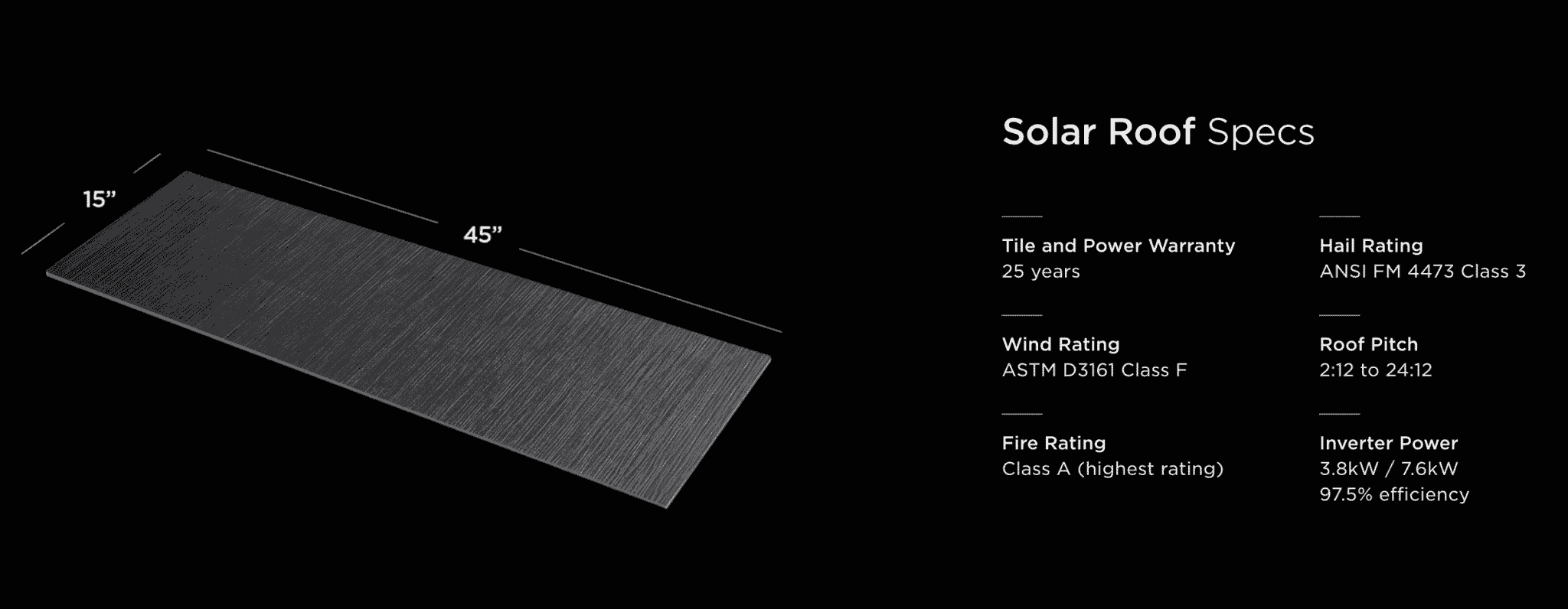
Tile and Power Warranty
The solar industry standard for an excellent warranty includes a minimum 25-year product and performance warranty; Tesla easily meets this qualification with its near comprehensive warranty. The Tesla Solar Roof comes with a 25-year warranty that is broken down into the Tesla solar product warranty, weatherization warranty and module warranty. Each of these warranty components applies to your solar roof as follows:
- Product Warranty: Guarantees that your solar roof is defect-free and remains intact for the full 25 years
- Weatherization Warranty: Guarantees that your Tesla Solar Roof system will still be attached to your roof and will prevent any wind or rain damage to your home for 25 years following its installation date
- Module Warranty: Guarantees that the power capacity of your Tesla Solar Roof will perform at 95% or more of its rated capacity for five years post-installation. After that, the power capacity should decline at a maximum of 0.5% per year for the remaining 20 years
Fire Rating
The Tesla Solar Roof has been awarded a Class A fire rating, which is the highest rating in the industry. This rating means that the flame spread rate for this solar power roof system will stay between zero and 25 mph, so this roofing material is rated excellent for fire resistance.
Hail Rating
For states that experience severe hail and thunderstorms, a roof’s hail rating is incredibly important. Tesla Solar Roofs have received a Class 3 hail rating, which means that the roof can withstand the impact of a hailstone up to a diameter of 1.75 inches.
Wind Rating
Tesla Solar Roofs have been given a Class F wind rating, which is also among the highest ratings awarded by the industry. This rating means that Tesla roofs can withstand winds up to 110 mph in speed (equal to around a Category 2 or 3 hurricane), so your roof should not lift off during severe storms that reach these wind speeds.
Roof Pitch
The angle — also known as the pitch — of your roof impacts how much solar energy production occurs. Tesla Solar Roofs are compatible with a roof pitch between 2:12 and 24:12. The most common pitch range is between 6:12 and 9:12, so Tesla Solar Roofs can be installed on nearly any roof and still produce energy in an optimal range.
Tesla Solar Inverter Power
Known for its sleek design, outstanding reliability and easy integration into your Tesla solar panel system, the Tesla solar inverter completes your solar system. Tesla offers different models for its solar inverter, so homeowners can choose the one that best suits their Tesla solar panels.
| Feature | 3.8 kW Model Specifications | 7.6 kW Model Specifications |
| Power | 3.8 kW | 7.6 kW |
| Integrations | Tesla App, Tesla Solar Roof, Tesla Powerwall, Wall Connector | Tesla App, Tesla Solar Roof, Tesla Powerwall, Wall Connector |
| CEC Efficiency | 97.5% at 208 V
97.5% at 240 V |
97.5% at 208 V
98.0% at 240 V |
| Warranty | 12.5 years | 12.5 years |
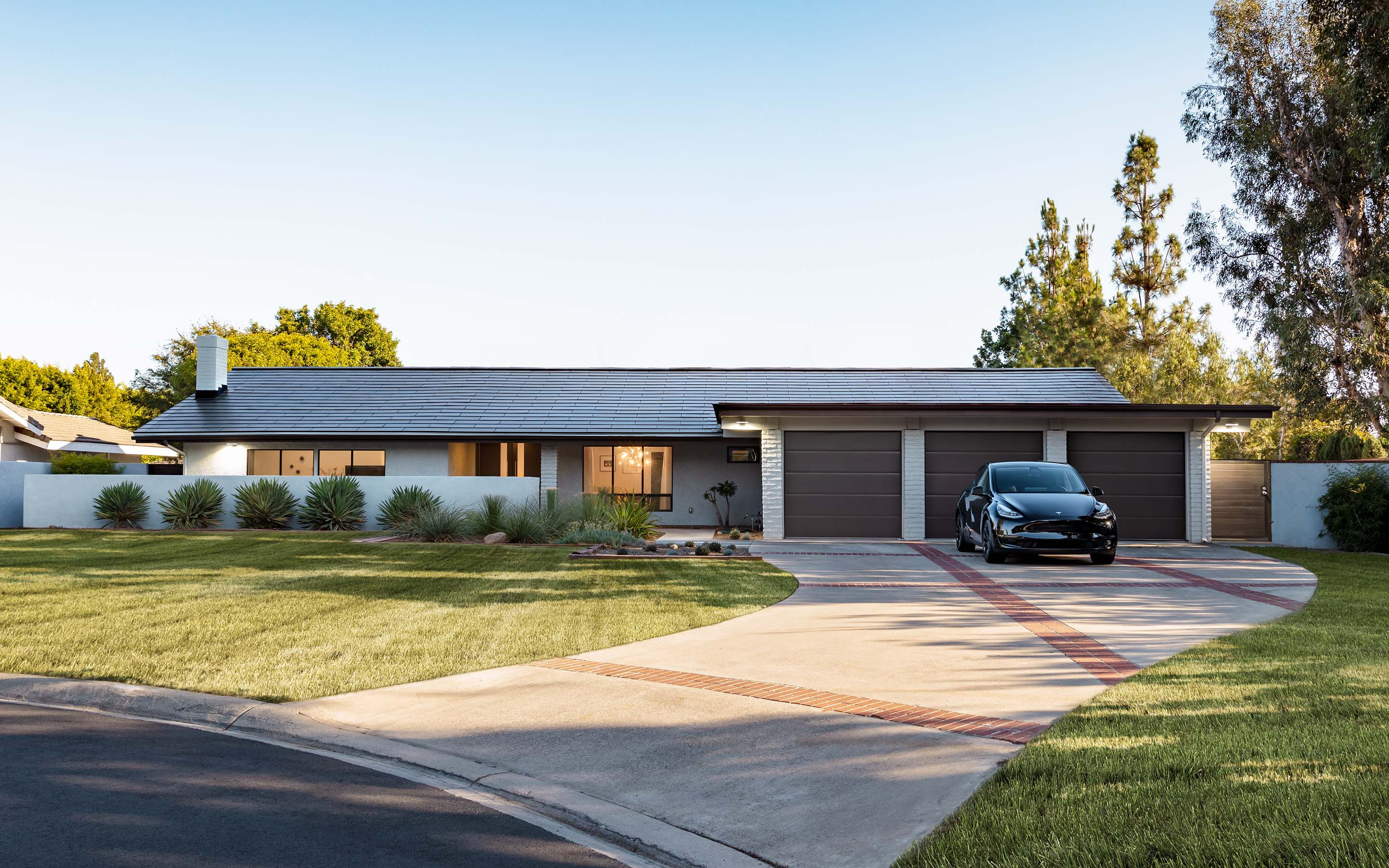
When Is a Tesla Solar Roof Worth It?
The Tesla Solar Roof is an excellent choice for homeowners who want to use the sun’s energy to offset their energy bill but don’t want to compromise their curb appeal. The Tesla Solar Roof may not be worth the added premium for most customers. Nevertheless, there are still times when a Tesla Solar Roof is worth it, such as:
- Your roof needs to be replaced
- You want solar panels but don’t like how solar systems look
- You live in a region with Tesla-certified installers
You Want Solar Panels But Don’t Like How Solar Systems Look
One of the most common complaints about solar panels is how they look once installed on your roof. Even modern black solar panels can look clunky and unattractive.
Tesla has solved this problem by developing a sleek, modern solar design that fulfills your renewable energy needs. If curb appeal matters to you, then Tesla Solar Roof is the perfect solution for your home.
Your Roof Needs to Be Replaced
If your roof needs to be replaced anyways, you should consider installing a Tesla Solar Roof — especially if you’re considering installing solar panels down the line. Once you factor in materials and labor, a new roof plus solar panels can be more expensive than a solar roof on its own. Depending on your roof, it can make more fiscal sense to install the Tesla Solar Roof, which provides your home with both protection and power for 25 years.
On paper, a standard roof appears far cheaper than a Tesla Solar Roof. However, you have to remember that when comparing against a solar roof, you have to factor in the amount you’ll spend on electricity over 25 years in addition to the roof itself.
After the federal tax credit is applied, and you account for 25 years worth of electricity costs, the Tesla Solar Roof can actually provide better value than a new roof installation with solar panels (and certainly better than one without solar panels). Check out the numbers below — the final cost of a roof and electricity over 25 years is found in the far right-hand column.
| Type of Roof | Upfront Cost | Total Cost After Federal ITC | Estimated Cost of Energy Over 25 Years | Net Cost Over 25 Years (Roof + Electricity) |
| New Roof | $18,000 – $70,000 | $18,000 – $70,000 | $61,483 | $79,483 – $131,483 |
| New Roof + Solar Panels | $40,500 – $92,500 | $31,986 – $97,972 | $0 – $10,000 | $40,500 – $102,500 |
| Tesla Solar Roof | $81,000 | $56,700 | $0 – $10,000 | $56,700 – $66,700 |
*Upfront cost of a new roof uses the average cost of a new metal roof in the United States; the new roof + solar panels section assumes the average cost to install solar is $29,970; and the average homeowner saves $31,513 in energy over 25 years. Actual prices will vary depending on your location, type of roof and brand of solar panel.
You Live In a Region With Tesla-Certified Installers
Historically, you could only get a Tesla Solar Roof if you lived within a certain distance of a Tesla warehouse. Tesla has since made its solar roof systems available to any homeowner in the United States and can send traveling installation teams. Tesla will also send out a certified professional to make sure your roof is a good candidate for its roof before installation.
Even though you can get a roof directly from Tesla, you should make sure that your local solar installers are Tesla-certified. Those who hold this certification know how to install Tesla shingles correctly and will make sure your system works properly.
You’re Considering Solar Panels for Your Roof
If you have considered solar panel installation for your roof, you should also compare the cost of a Solar Roof to that of a Tesla solar panel system. For the same house we used in the above example, Tesla suggests a 8.1 kW solar panel system with a Powerwall II home battery and quotes a notably lower estimated price of $16,346 after the federal credit.
| Tesla Solar Panels
+ Powerwall |
Tesla Solar Roof + Powerwall | Tesla Solar Roof | |
| Size Needed | 8.1 kW | 8.1 kW | 8.1 kW |
| Cost After Tax Credit | $16,346 | $57,531 | $46,031 |
Tesla Solar Roof Pros and Cons
As we have covered thus far, the most significant advantages to a Tesla Solar Roof include unparalleled aesthetics with excellent durability. However, solar shingles yield slightly less energy than traditional solar panels and carry a higher price tag.
Tesla Solar Roof Pros
- Superior aesthetics
- Several design choices
- Excellent warranty coverage
- High durability
Solar Design Aesthetics
One of the biggest benefits of Tesla Solar Roofs is the appearance. Not only are these solar shingles built to resemble a roof’s style, but the shingles are so low-profile that your neighbors won’t even know that you’ve installed solar-harnessing tiles on your roof.
Several Design Choices
Tesla Solar Roofs are designed to appeal to the modern homeowner, but Tesla takes this design one step further by offering several design choices so that homeowners can match the style of their home. You can get your Tesla Solar Roof in styles that resemble textured, Tuscan, smooth or slate tiles.
Tesla’s Excellent Warranty
The industry standard warranty is 25 years, and Tesla meets this criteria with flying colors. With a product, performance and weatherization warranty, homeowners will not have to worry about their Tesla roof breaking down or causing damage. Plus, your roof will remain protected from the elements.
Highly Durable Solar Option
Tesla solar roofs are rated to withstand some of the most severe weather conditions around, so you won’t have to worry about your home being damaged from high wind, hail or rain. This durability makes Tesla solar roofs an excellent choice for homeowners across the country.
Tesla Solar Roof Cons
- Expensive
- Lower efficiency than traditional systems
- Long wait period prior to installation
- Unknown maintenance costs
Expensive Option vs Traditional Solar Panels
Tesla solar roofs are among the most expensive solar shingles on the market, so many budget-conscious homeowners choose to go another route. Even though the roof’s PV will help to offset future energy costs, the upfront cost can come as quite the sticker shock.
Efficiency Lower Than Traditional Systems
As seen in the tables above, the efficiency rating for Tesla solar roofs is lower than some of the other industry leaders. This does make most homeowners question whether these solar tiles are worth the extra cost, especially if the tiles are intended to offset energy costs, not just look stunning on a roof.
Long Wait Period for Tesla Products
If you have decided to install a Tesla solar roof, then you better plan well ahead of time because the current lead times for roof installation are between one and six months. But, the wait period tends to lean more towards the three to six month timeline. Homeowners who want to get their solar roof installed more quickly will need to choose another provider.
Unknown Maintenance Costs
Because Tesla’s solar roof is such a new product, it is nearly impossible to determine the maintenance costs. The solar roofs are designed to be low maintenance, but this is difficult to determine due to how short the product has been on the market. Unlike traditional solar panels, you may not have certified technicians who know how to fix Tesla panels should they break down.
5 Steps to Getting a Solar Roof Installed
The installation process of a Tesla Solar Roof is similar to a traditional solar panel installation but requires more time. You can order your Solar Roof directly through Tesla’s website or a certified Tesla roof installer. Bear in mind that you must live in Tesla’s coverage area for Solar Roof installations. In more remote areas, it may not be possible just yet.
Here is a list of the steps involved:
- Place Order: The first step in placing your order is paying a deposit of $250. Orders are placed through Tesla’s website after you have reviewed the estimated size and price of your system. Tesla uses your average electricity bill to recommend a system size.
- Assessment: The numbers on Tesla’s design page are based on basic approximations, and a proper design of your solar roof system will require a more detailed assessment. For this, Tesla’s engineers will assess your location virtually using satellite imagery. You will also be required to submit your full electric bill for Tesla to better understand your energy needs. If the assessment shows that your home isn’t a good candidate for a Solar Roof, Tesla will refund your deposit.
- Permits: Your city and utility company will treat your Solar Roof like any other solar power system, meaning you will require permits to install and operate the solar tiles on your roof. This step may take a few weeks, depending on where you live.
- Installation: Once you have the permits, the technicians will tear down your existing roof and install the new solar roof. This may take a week or more based on the size and complexity of your roof.
- Inspection and Permission to Operate (PTO): Once installed, your system will be inspected for safety by both your city (in some cases county) and your utility. Before you can turn your system on, you’ll need to receive written permission to operate (PTO) from your utility. The company installing your system will likely take care of the paperwork.
The best way to find out if the Tesla Solar Roof is right for you is to connect with a local solar company. Some solar companies are certified by Tesla to sell and install Solar Roofs. You can get started by clicking below
The cost information presented in this article is derived from a comprehensive analysis, incorporating data from multiple industry sources. The average cost per watt per state was calculated based on figures from Consumer Affairs, Energy Sage, and Berkeley Lab’s Electricity Markets & Policy Department. Additionally, monthly energy consumption and the average monthly cost of electricity were sourced from the U.S. Energy Information Administration, ensuring a well-rounded and accurate representation of the information presented.
FAQs: Tesla Solar Roof Cost & Review
The total cost of your Tesla Solar Roof will vary depending on where you live and the square footage of your roof, so it’s hard to give an exact figure.
On average, it typically takes between 9 and 15 years for homeowners to pay off solar panel roof products, but with fully integrated solar roofing material being more expensive than panels you can expect upwards of 20 years or more.
The answer to this question depends on the size of your roof, how much direct sunlight it receives and your household energy needs. Under the right conditions, a Tesla Solar Roof could power an entire house, especially if paired with a Tesla Powerwall battery.
However, because solar shingles are less efficient compared to solar panels, the Tesla Solar Roof may not be the best solar product for power-hungry home, but it may still significantly reduce your monthly electricity bills.
The Solar Roof uses solar and non-solar tiles. Their non-solar roof tiles cost roughly $13 per square foot. The typical homeowner can expect to pay $28 per square foot of solar roof, which considers about 35% of the roof is solar and the rest is non-solar tiles.2

 233k
233k  41k
41k  Subscribe
Subscribe 
